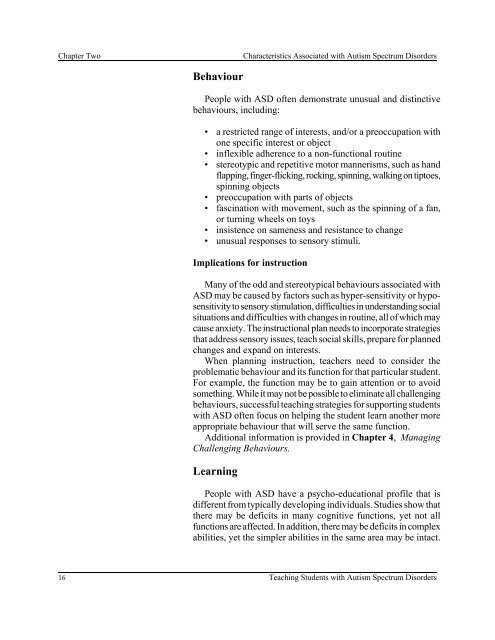Teaching Students with Autism Spectrum Disorders
Teaching Students with Autism Spectrum Disorders
Teaching Students with Autism Spectrum Disorders
You also want an ePaper? Increase the reach of your titles
YUMPU automatically turns print PDFs into web optimized ePapers that Google loves.
Chapter Two Characteristics Associated <strong>with</strong> <strong>Autism</strong> <strong>Spectrum</strong> <strong>Disorders</strong><br />
Behaviour<br />
People <strong>with</strong> ASD often demonstrate unusual and distinctive<br />
behaviours, including:<br />
• a restricted range of interests, and/or a preoccupation <strong>with</strong><br />
one specific interest or object<br />
• inflexible adherence to a non-functional routine<br />
• stereotypic and repetitive motor mannerisms, such as hand<br />
flapping, finger-flicking, rocking, spinning, walking on tiptoes,<br />
spinning objects<br />
• preoccupation <strong>with</strong> parts of objects<br />
• fascination <strong>with</strong> movement, such as the spinning of a fan,<br />
or turning wheels on toys<br />
• insistence on sameness and resistance to change<br />
• unusual responses to sensory stimuli.<br />
Implications for instruction<br />
Many of the odd and stereotypical behaviours associated <strong>with</strong><br />
ASD may be caused by factors such as hyper-sensitivity or hyposensitivity<br />
to sensory stimulation, difficulties in understanding social<br />
situations and difficulties <strong>with</strong> changes in routine, all of which may<br />
cause anxiety. The instructional plan needs to incorporate strategies<br />
that address sensory issues, teach social skills, prepare for planned<br />
changes and expand on interests.<br />
When planning instruction, teachers need to consider the<br />
problematic behaviour and its function for that particular student.<br />
For example, the function may be to gain attention or to avoid<br />
something. While it may not be possible to eliminate all challenging<br />
behaviours, successful teaching strategies for supporting students<br />
<strong>with</strong> ASD often focus on helping the student learn another more<br />
appropriate behaviour that will serve the same function.<br />
Additional information is provided in Chapter 4, Managing<br />
Challenging Behaviours.<br />
Learning<br />
People <strong>with</strong> ASD have a psycho-educational profile that is<br />
different from typically developing individuals. Studies show that<br />
there may be deficits in many cognitive functions, yet not all<br />
functions are affected. In addition, there may be deficits in complex<br />
abilities, yet the simpler abilities in the same area may be intact.<br />
16 <strong>Teaching</strong> <strong>Students</strong> <strong>with</strong> <strong>Autism</strong> <strong>Spectrum</strong> <strong>Disorders</strong>

















